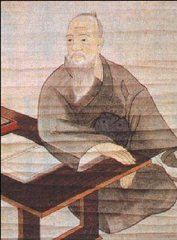Name Sai On | ||
 | ||
Sai On (蔡温)(1682–1761), also known as Gushi-chan Bunjaku (具志頭文若, lit. Bunjaku, head of Gushi) was a scholar-bureaucrat official of the Ryukyu Kingdom, serving as regent, instructor, and advisor to King Sho Kei. He is renowned for the many reforms he initiated and oversaw, and is among the most famous figures in Okinawan history.
Life and career
Sai On was born in Kumemura, the village within the major port city of Naha which served as the chief center of classical Chinese learning in Okinawa, and the source of the vast majority of the scholar-bureaucrats who were raised to serve in the administration of the kingdom. His father had likewise been a scholar-bureaucrat of Kumemura, educated in the Confucian classics, and had served on several tribute missions to China. At the age of 27, Sai On traveled to Guangzhou in China, where he studied economics, geography, and political administration alongside the more traditional Chinese classics.
Upon returning from China, Sai On was made instructor to the Crown Prince; upon the prince's accession to the throne as King Sho Kei in 1713, Sai On was elevated in position and power, and led the investiture mission to China in 1716. In 1728, he became a member of the Sanshikan, the Council of Three chief royal advisors. Though Sai On was not of royal blood and so could not be named Sessei (a post which historian George Kerr translates as "prime minister"), reorganizations were undertaken within the government allowing Sai On extensive authority and powers. Under his guidance, a number of land reforms were put into place, including the reclamation of land for agriculture, relocation and establishment of settlements, irrigation, flood control, and the planting of trees. In a series of reforms very similar to those implemented in Japan around the same time, strict limitations were placed on farmers moving to the cities, and on the amount of craft work, such as woodworking and metalworking, which farmers were permitted to do. Thus, agricultural production was intensified and made more efficient while artisans were focused in the twin cities of Naha and Shuri. Within a few years of the beginning of the implementation of Sai On's economic reforms and construction, reclamation and conservation projects, the kingdom was producing more than ever before.
In addition, the anji, hereditary lords of territories throughout the kingdom, were given stipends from the government in the form of rice, beginning in 1723. This tied them closer to the central government and also safeguarded to some extent their economic well-being, as they would no longer need to rely solely on inheritance for their relative wealth. Aristocrats were also encouraged to become artisans, with no loss of court rank or status, and in 1734, taxes upon artisans in the cities were eliminated, further encouraging an expansion of craft production. In addition, various forms of official government recognition for exemplary artisans, artists, and performers were introduced.
Okinawa's demand for wood outstripped the ability of the forests to renew themselves on their own, naturally, and the combination of deforestation and rainy weather including regular typhoon seasons led to extensive erosion and landslides. Sai On is particularly known for the forestry and soil conservation efforts undertaken under his guidance to combat these problems. Particular trees and sections of forest throughout the islands are still today called "Sai On pines" (蔡温松, Sai On matsu; 蔡温並木, Sai On namiki), and his essays on the subject of forestry and conservation remained so valued that the post-war United States Civil Administration of the Ryukyu Islands translated, published, and distributed them abroad in 1952. In addition to these essays, Sai On produced a number of other documents, including a handbook for administrative officials in the provinces entitled Yomui-kan, and Ryokonin Kokoroe (旅行人心得), or "Travelers' Advice", a guide for Okinawans abroad in China to help them in obscuring from the Chinese the relationship between Okinawa and Japan's Satsuma Domain.
A rival government faction rose up against Sai On in 1734, accusing him of being too pro-Chinese, led by a pair of scholar-bureaucrats, Heshikiya Chobin and Tomoyose Anjo. Before any plots against Sai On could be executed, however, Chobin and fourteen others were arrested and put to death.
Sai On retired from his ministerial post in 1752, the year after Sho Kei's death, but remained influential until his own death at the age of 79 in 1761.
